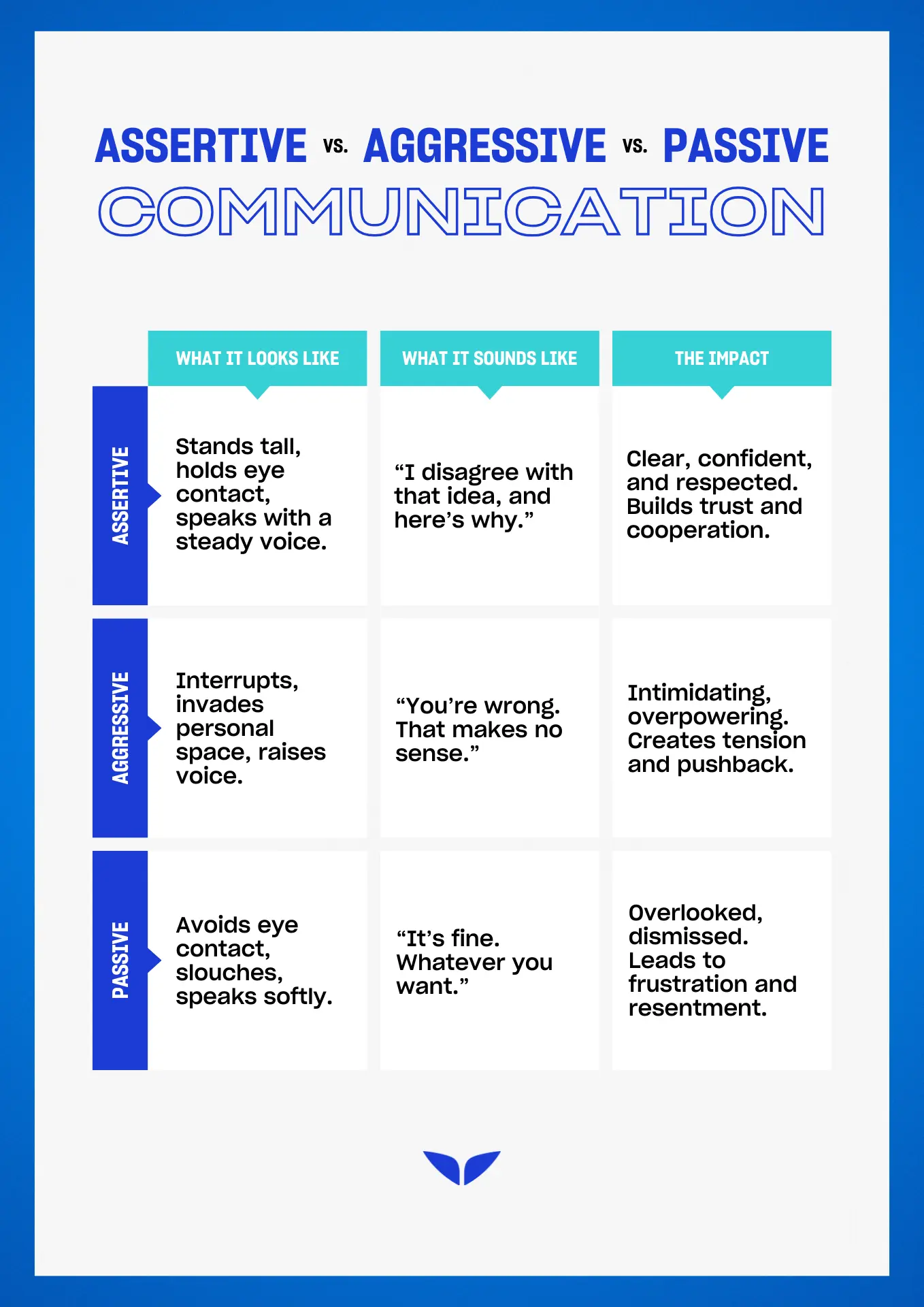You know that person who always gets what they want without breaking a sweat? The one who shuts down nonsense with a single sentence, but never seems rude?
That’s the power of assertive communication skills—zero fluff, maximum respect. And yet, so many people get it wrong.
“Most people think that to get respect or to be assertive, they can’t be liked,” says Vanessa Van Edwards, a speaker with Science of People and the trainer of Mindvalley’s program, Magnetic Charisma. “You can be both likable and respected, and you don’t have to sacrifice who you are.”
The thing is, you don’t have to raise your voice to be heard. You definitely don’t have to bulldoze people to get what you want.
Assertive people have two things. They know what they want and they know how to clearly communicate it.
— Vanessa Van Edwards, trainer of Mindvalley’s Magnetic Charisma program
And once you master it? You’ll never have to apologize for taking up space again.
What are assertive communication skills?
Assertive communication is direct, clear, and impossible to ignore. Because you speak with purpose, set boundaries, and own your voice, you balance between being a doormat and a bulldozer.
Vanessa explains it as “the ability to confidently express your opinions, feelings, and needs directly, honestly, and respectfully.” And here’s how that looks in everyday conversations:
- Speaking with confidence. No mumbling, no hedging, no “Uh, I guess maybe?”
- Setting boundaries. Saying no without guilt, and yes without pressure.
- Holding eye contact. Not a death stare, just enough to show you mean business.
- Using “I” statements. “I need more time,” instead of “You’re rushing me.”
- Standing your ground. No backpedaling just because someone frowns.
“Assertive people have two things,” she adds. “They know what they want and they know how to clearly communicate it.”
In fact, most professionals claim to operate this way. A 2023 global survey by the Niagara Institute found that 75% of professionals say assertiveness is their dominant style. Still, 32.2% hesitate when it matters.
That hesitation often has to do with body language. Social psychologist Amy Cuddy, in her TED talk, found that holding strong, open postures for just two minutes boosts confidence, lowers stress, and makes assertiveness second nature.
The way you stand, the space you claim, the presence you bring shape how people respond to you. And the impact is undeniable, leading, according to research, to:
- Greater job satisfaction, happiness at work, and less stress.
- Higher self-esteem, better communication skills, and a stronger sense of self-worth.
- Healthier, more balanced, and more satisfying relationships.
So if you’ve ever wondered, “How can assertive communication skills help me to develop a healthy lifestyle?”—this is how. When you set boundaries and express your needs, your emotional and physical health benefits.
Assertive vs. aggressive vs. passive communication
Let’s get something clear: not all communication styles are created equal.
Some people steamroll their way through conversations. Others shrink and avoid conflict at all costs. And then there are those who speak clearly, hold their ground, and still keep things respectful.
So what’s the difference between them? Here’s a quick breakdown of three common communication styles to help you spot the difference clearly.
| Style | What it looks like | What it sounds like | The impact |
| Assertive | Stands tall, holds eye contact, speaks with a steady voice. | “I disagree with that idea, and here’s why.” | Clear, confident, and respected. Builds trust and cooperation. |
| Aggressive | Interrupts, invades personal space, raises voice. | “You’re wrong. That makes no sense.” | Intimidating, overpowering. Creates tension and pushback. |
| Passive | Avoids eye contact, slouches, speaks softly. | “It’s fine. Whatever you want.” | Overlooked, dismissed. Leads to frustration and resentment. |
Soft skills hit hard. They’re what make your words land instead of bounce.
And knowing how to express yourself with confidence—not aggression or hesitation—changes the way people respond to you.

Why assertive communication matters
Speaking up with clarity and confidence gets results. That’s why assertive communication skills training is so valuable; it teaches you how to make your voice heard in any conversation.
Most people don’t realize assertiveness is actually a social skill.
— Vanessa Van Edwards, trainer of Mindvalley’s Magnetic Charisma program
Picture this for a second: You’re in a meeting. You have an idea and as words start coming out of your mouth, someone talks over you. Do you let it slide, or do you calmly say, “I’d like to finish my thought”?
“Assertive people get more done because they communicate so effectively they have easier communications,” according to Vanessa. That’s how things move forward—with clear words and zero wasted time.
Master this and you:
- Gain respect. People listen when you speak with purpose.
- Avoid burnout. Having effective communication skills sets boundaries and prevents overwhelm.
- Build stronger relationships. Honesty and directness create trust.
- Reduce stress. Saying what you mean takes the pressure off things.
- Make better decisions. Standing firm keeps you from being pressured into choices you don’t want.
No more second-guessing. No more letting people bulldoze your voice. Speak assertively, and you’ll never let anyone else steer your conversations again.
9 real-life examples of assertive communication skills
Assertiveness shows up in everyday moments: the way people set boundaries, handle disagreements, or make their voices heard. Some moments need confidence. Others need calm. But the right words always land.
Here are some examples where having a commanding presence can turn the tide.
In a workplace
Your boss dumps another deadline on your desk. A colleague talks over you like you’re not even there. A meeting drags on, and the loudest voice wins—again.
The workplace is a battlefield of power plays and unspoken rules. Words get ignored. Posture doesn’t. And based on what Amy says in her TED talk, your body language in the workplace speaks before you do.
Some people fade into the background. Others walk in like they belong.
The difference? Confident, clear communication, just like these powerhouses:
- Oprah Winfrey vs. 60 Minutes. 60 Minutes tried to tone Oprah down. Bad idea. When producers told her to sound more neutral, she walked. Workplace communication is about authenticity, and she refused to compromise hers.
- Blanca Azpurua finding her voice. Through Mindvalley’s Speak and Inspire program, she strengthened her assertiveness and learned to lead conversations with clarity and conviction. Now, she speaks with confidence and purpose.
- Bob Iger outmaneuvering Steve Jobs. The latter wasn’t easy to negotiate with, but Bob didn’t flinch. He stayed steady, met resistance with reason, and built trust. The result? Disney got Pixar, and Bob got the deal of a lifetime.
In a relationship
Words matter, especially when it’s tough. The best relationships handle hard conversations directly, ensuring their voices are heard.
And it starts early—assertive communication skills for kids can shape how they navigate friendships, express their needs, and handle conflicts with confidence. Teaching them to say “I don’t like that” instead of shutting down or lashing out builds the foundation for healthy relationships later in life.
When it comes to adult relationships, these couples proved that clear dialogue is everything.
- Michelle Obama and boundary-setting with her husband. With Barack’s political career demanding so much of his time, Michelle had to set limits to keep their family life from falling entirely on her shoulders. She made sure their home life remained a shared responsibility, not something she carried alone.
- Will Smith and Jada Pinkett Smith on Red Table Talk. Instead of dodging the tough topics, they sat down, addressed them head-on, and spoke with raw honesty. No deflections, no half-truths—just direct, assertive communication in real-time.
- Beyoncé addresses infidelity in Lemonade. She put every emotion on the table instead of staying silent or speaking in vague terms. Through her music, she expressed her pain, set her expectations, and made it clear what she would and wouldn’t accept in her marriage.
During a conflict resolution
When the heat is on, assertive communication separates the ones who buckle from the ones who break through. It’s about standing firm, cutting through noise, and speaking up when everything’s on the line.
Some moments demand more than words. These moments proved it:
- Volodymyr Zelensky and Russia’s invasion. Leading a country at war meant dealing with confrontation on a global scale. Instead of folding under pressure, he took a firm stance that rallied his country and secured worldwide support.
- Serena Williams and the U.S. Open umpire. The U.S. Open umpire made a bad call, and Serena wasn’t about to let it slide. She called it out—calmly, directly, no theatrics.
- Pope Francis and the Church abuse scandal. The Church’s scandals were an open wound, and Pope Francis didn’t try to slap a bandage on it. He faced it head-on, owning the failures instead of dodging them.
How to improve assertive communication skills
“Most people don’t realize assertiveness is actually a social skill,” says Vanessa. And like any skill, it gets stronger with practice.
The right words, the right tone, the right presence—master these, and you won’t just speak. You’ll command attention.
1. Speak with purpose
Mumbling? Hedging? Apologizing before you’ve even said your point? Kill all of it. Speak clearly. Speak directly. Own your words.
- Drop the fillers. Cut the “I just think,” “Maybe it’s just me,” or “Does that make sense?” If you said it, you meant it.
- Stick to “I” statements. “I need more time” lands better than “You’re rushing me.” Own your words.
- Keep your tone steady. No trailing off, no second-guessing. Confidence is as much in how you say something as what you say.
Vocal presence shapes how people perceive you. In a study Vanessa highlights in her Mindvalley program, doctors who spoke with questioning inflections and nervous pitch were rated lower in competence and warmth. Patients who perceived them as less competent were also more likely to sue them.
As Vanessa explains, “When we hear the question used on a statement, we begin to question the listener.” If your voice rises at the end of a sentence when you’re not actually asking a question, people subconsciously start doubting you. Instead of sounding sure, you sound unsure.
And uncertainty kills credibility. If you want people to trust what you’re saying, own your words, drop the hesitation, and speak like you mean it.
2. Listen like it matters
Listening isn’t optional. Tune out, and you might as well leave the room.
- Stop rehearsing your response. If you’re busy planning what to say next, you’re not listening. Stay present.
- Show you’re engaged. Nods, eye contact, and the occasional “Got it” or “Tell me more” go a long way.
- Pause before jumping in. Give their words a second to land instead of rushing to reply.
According to Vanessa, people notice engagement through your reactions, your tone, and the way you respond.
She suggests “listening to see if you can hear similarities and highlight them.” Use simple phrases like “me too,” “I love that,” and “I agree” to highlight connections and build influence.
When you genuinely use your active listening skills, you create stronger conversations, deeper relationships, and more meaningful interactions.
Because when people feel heard, they actually start listening to you.
3. Own your space
Slouching, fidgeting, shrinking into the background. It’s a silent way of saying, “Don’t mind me.” That’s why, when it comes to assertive communication, you need to mind your non-verbal cues, not just your words.
Here are a few simple shifts you can make:
- Stand tall. Shoulders back, feet planted. Confidence starts with posture.
- Take up space. Don’t fold into yourself. Own your spot at the table.
- Hold steady eye contact. No staring contests, just enough to show you’re engaged.
Amy found that posture affects mindset. “Tiny tweaks can lead to big changes,” she says. She and her fellow researchers found that standing in an open, powerful stance for just two minutes can lower stress hormones and boost confidence.
Your posture isn’t just posture. It’s your silent mic drop.
4. Set boundaries and mean it
A boundary is a line, not a debate. If you don’t enforce it, it disappears.
People will test limits. Some push. Others ignore. The response is the same—hold your ground.
- Say it straight. “I can’t take on extra work” is stronger than “I’m kind of overwhelmed right now.”
- Hold the line. If someone oversteps, call it out. Once you cave, they’ll keep pushing.
- Repeat as needed. The people who respect your boundaries won’t need constant reminders. The ones who don’t? They’ll test you until they realize you won’t bend.
Lisa Nichols, the CEO of Motivating the Masses and trainer of the Speak and Inspire program on Mindvalley, doesn’t sugarcoat it: people will only respect the boundaries you enforce.
“You train people to treat you the way they’re treating you,” she points out. If they call at all hours, it’s because you always pick up. If they expect too much, it’s because you always say yes.
Now, the challenge: retraining them. Set the boundary, stand by it, and watch how quickly people learn that “no” actually means no.
5. Plan your words
Winging it works for karaoke. For communication? Not so much.
If you want your message to land, you need to be deliberate with your words.
- Get to the point. Rambling loses people. Say what needs to be said—nothing more, nothing less.
- Think before you speak. Blurting out half-formed thoughts weakens your impact. Take a breath, organize your ideas, then deliver.
- Paint a picture. People remember stories, not speeches. Instead of listing facts, show them what you mean.
Lisa teaches that the most effective communicators bring stories to life. “Every time you speak, you want to be able to deliver an oral movie,” she explains.
So, instead of saying, “I was nervous,” describe the feeling—hands sweating, heart pounding, voice catching in your throat.
The fact is, words have weight, but delivery decides if they hit or disappear.
Spark conversations that matter
Your words shape the way people see you. So why waste them on small talk?
With the right prompts, every conversation can be meaningful, memorable, and worth having. Mindvalley’s free deck of conversation starters, aptly called The Connection Kit, gives you the perfect way to break the ice, deepen connections, and make every chat count.
Whether you’re networking, negotiating, or just craving better conversations, these prompts turn everyday talk into something real. No fluff. No awkward silences. Just words that carry weight.
Ready to start talking with purpose? Download your free deck and make every conversation matter.
Welcome in.










